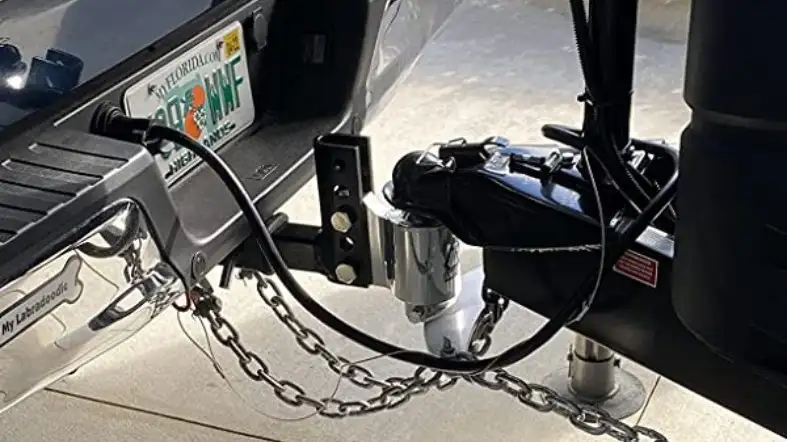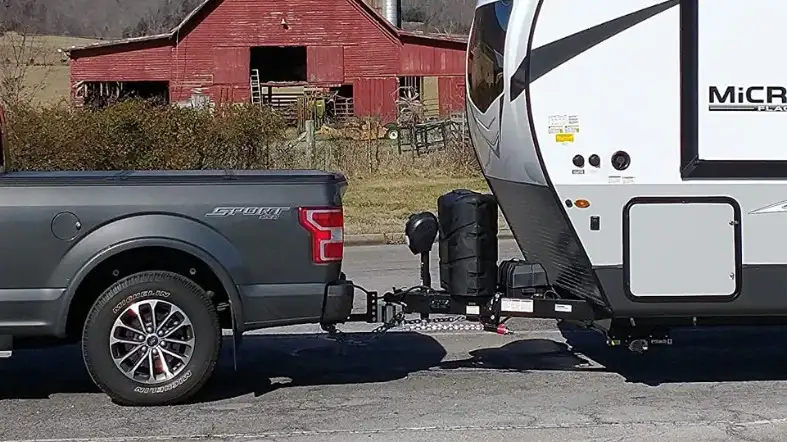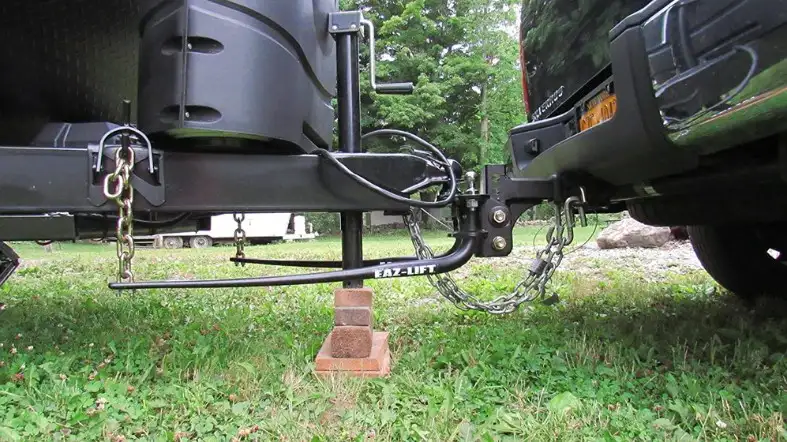When do you need a weight distribution hitch?
Most people would say that you only need a weight distribution hitch when towing a heavy load.
This is actually not the case.
You may also need a weight distribution hitch when driving a camper or heavily loaded vehicle.
Unlikely as it seems, even a small car can benefit from using this piece of equipment.
Let’s take a look at some reasons why you might need a weight distribution hitch and how it can help improve your driving experience.
When Do You Need A Weight Distribution Hitch?
There are many different situations in which a weight distribution hitch can be beneficial.
One of the most common scenarios where a weight distribution hitch is helpful is when you are towing a trailer or boat behind your vehicle.

These types of vehicles often have heavier loads, and without proper weight distribution, it can be difficult to navigate turns smoothly or control your vehicle in rough weather or terrain.
A weight distribution hitch can help to very evenly distribute the weight of your trailer, which in turn helps to improve handling and control when driving.
1. When Towing a Heavy Load
If you are planning on towing a heavy load, you will need a weight distribution hitch.
This type of hitch helps to distribute the weight of the load evenly, which prevents the trailer from becoming overloaded on one side.
Additionally, a weight distribution hitch can help to improve the stability of the trailer, making it less likely to tip over.
2. When Towing an Oversized Load
If you are planning on towing an oversized load, you will also need a weight distribution hitch.
This is because an oversized load can put too much pressure on one side of the trailer, causing it to become unstable and potentially tip over.
A weight distribution hitch helps to distribute the weight of the load evenly, preventing this from happening.
3. When Towing in Windy Conditions
If you are planning on towing in windy conditions, you will need a weight distribution hitch.
This is because the wind can push against the side of the trailer, causing it to become unstable and potentially tip over.
A weight distribution hitch helps to distribute the weight of the load evenly, preventing this from happening.
4. When Towing on Uneven Roads
If you are planning on towing on uneven roads, you will also need a weight distribution hitch.
This is because uneven roads can cause the trailer to become unstable and potentially tip over.
A weight distribution hitch helps to distribute the weight of the load evenly, preventing this from happening.
5. When Towing in mountainous terrain
If you are planning on towing in mountainous terrain, you will definitely need a weight distribution hitch.
This is because mountainous terrain can be very treacherous and even dangerous for trailers that are not properly equipped.
A weight distribution hitch helps to distribute the weight of the load evenly, making it less likely for the trailer to tip over.
How does a weight distribution hitch work?
A weight distribution hitch works following some simple principles:
- A weight distribution hitch is a type of trailer hitch that helps to distribute the weight of the trailer more evenly between the tow vehicle and the trailer.
- The weight distribution hitch consists of a frame that attaches to the tow vehicle, as well as a spring bar assembly that attaches to the trailer.
- The spring bar assembly is connected to the frame via a series of chains or cables.
- When the tow vehicle and trailer are connected, the weight of the trailer is transferred to the spring bars, which helps to distribute the weight more evenly between the tow vehicle and the trailer.
What Are The Types Of Weight Distribution Hitches?

Weight distribution hitches are devices that are used to distribute the weight of a trailer evenly across the axle of a tow vehicle.
There are two types to choose from:
Sliding Weight Distribution Hitches
Sliding weight distribution hitches have a mechanism that allows the hitch head to move side-to-side, which helps to distribute the weight of the trailer evenly over the axles of both the tow vehicle and the trailer.
Non-Sliding Weight Distribution Hitches
Non-sliding weight distribution hitches do not have a mechanism that allows the hitch head to move side-to-side.
Instead, this type of hitch uses chains or bars to distribute the weight of the trailer evenly over the axles of both the tow vehicle and the trailer.
These types of hitch are typically used for trailers based on their weight.
| Weight distribution hitch | Used for |
|---|---|
| Sliding weight distribution hitches | Heavier than 10,000 pounds |
| Non-sliding weight distribution hitches | Lighter than 10,000 pounds |
How To Install A Weight Distribution Hitch?
Installing a weight distribution hitch can be a complex process, especially if you are not familiar with the components and tools involved.
Generally, there are five steps to installing a weight distribution hitch:
Choosing the Right Weight Distribution Hitch
The first step in installing a weight distribution hitch is to choose the right hitch for your vehicle.
There are a variety of hitch types available on the market, so it is important to select one that is compatible with your vehicle and trailer.
Additionally, you will need to choose a hitch that has the appropriate weight capacity for your needs.
Installing the Weight Distribution Hitch
Once you have selected the right hitch for your needs, you will need to install it on your vehicle.
This process will vary depending on the type of hitch you have chosen, but most hitches can be installed using basic hand tools.
If you are unsure about how to install your hitch, consult the manufacturer’s instructions or seek professional assistance.
Adjusting The Weight Distribution Hitch

After the hitch has been installed, you will need to adjust it to ensure that it is properly distributing the weight of your trailer.
This process will again vary depending on the type of hitch you have, but most hitches can be adjusted using a simple wrench or screwdriver.
Once you have adjusted the hitch, be sure to check that it is still secure and not causing any damage to your vehicle or trailer.
Loading Your Trailer
Once your weight distribution hitch has been installed and adjusted, you can then load your trailer onto your vehicle.
Be sure to distribute the weight of your trailer evenly across all axles to prevent problems when driving.
Additionally, make sure that all trailer lights are working properly before setting out on your journey.
Driving with a Weight Distribution Hitch
When driving with a weight distribution hitch, there are a few things you should keep in mind.
First, always drive slowly and carefully, as sudden stops or turns can cause problems with the distribution of weight.
Additionally, avoid driving in extreme weather conditions, as high winds or heavy rain can also affect the performance of your hitch
How To Use A Weight-Distribution Hitch?

Once your weight distribution hitch is properly set up, you will use it just like any other trailer hitch.
The first step
You have to determine the tongue weight of your trailer.
Tongue weight is the amount of weight that is exerted on the hitch by the trailer.
This can be done by placing a scale under the tongue of the trailer and weighing it.
Next,
You will need to adjust the weight distribution hitch to distribute the tongue weight evenly across the axle of the trailer.
To do this, you will need to adjust the chains or bars that are attached to the hitch.
Finally,
You will need to attach the weight distribution hitch to your vehicle.
This can be done by attaching the hitch to the frame of your vehicle or to the bumper, depending on what type of hitch you have.
FAQs about When you need a weight distribution hitch
When Do You Need A Weight Distribution Hitch?
You may need a weight distribution hitch when you are towing a heavy trailer.
This type of hitch can help to improve handling and braking by distributing the weight more evenly between the tow vehicle and the trailer.
What Are The Benefits Of Using A Weight Distribution Hitch?
There are several benefits of using a weight distribution hitch, including improved handling and braking, increased stability, and reduced wear on your tow vehicle and trailer.
Are There Any Disadvantages To Using A Weight Distribution Hitch?
One potential disadvantage of using a weight distribution hitch is that it can add some complexity to hooking up and disconnecting your trailer.
Additionally, if not properly adjusted, a weight distribution hitch can actually make your vehicle less stable.
The final thought
When do you need a weight distribution hitch?
A weight distribution hitch is necessary anytime you are towing something that exceeds the tow rating of your vehicle.
This includes trailers with a gross trailer weight (GVW) that is more than the tow rating of your car, truck, or SUV.
In addition, if you’re carrying a heavy load in your vehicle’s bed – even if the GVW of the trailer is within the tow rating of your vehicle – you’ll also need a weight distribution hitch.
